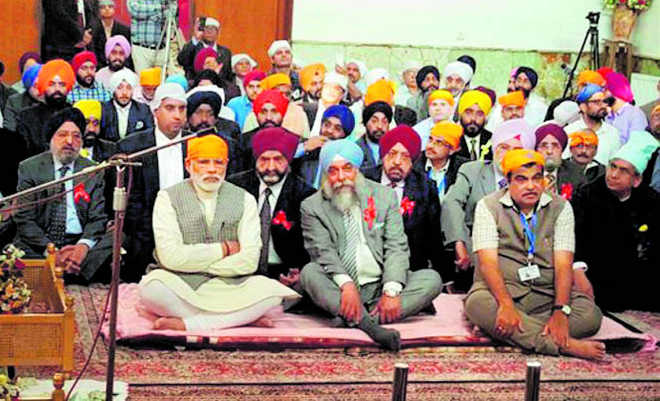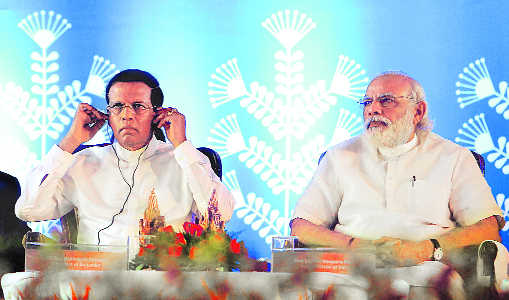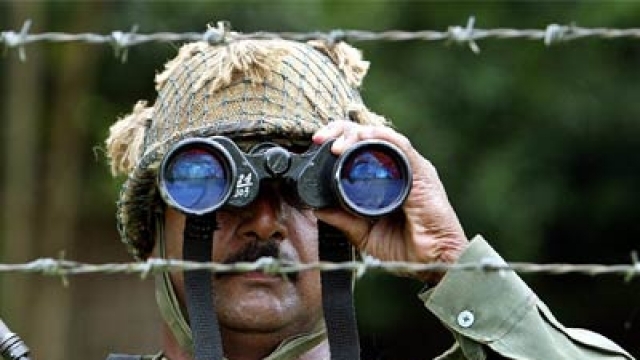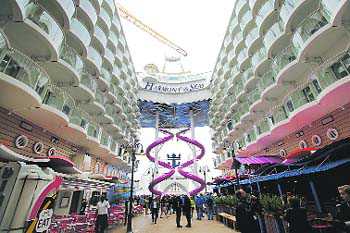Prime Minister Narendra Modi and Union minister for transport Nitin Gadkari (extreme right) at Bhai Ganga Singh Sabha Gurdwara in Tehran on Sunday. On a two-day visit to Iran, Modi promised a large-scale celebration during Guru Gobind Singh’s 350th birth anniversary. TEHRAN: Prime Minister Narendra Modi on Sunday began his crucial two-day visit to Iran with a visit to the capital city’s only functioning gurdwara.
Modi, the first Indian Prime Minister to visit Iran in 15 years, offered his obeisance at the Bhai Ganga Singh Sabha Gurdwara and spoke to the head priest. He applauded the efforts of the Sikh community in the Persian Gulf nation for preserving and spreading the culture and traditions of India.
“My Iran visit is starting with the blessings before the Guru Granth Sahib at this gurdwara. I am fortunate. I greet you all for having worked on spreading our culture and tradition as well as educating our young generation here,” Modi said.
“We accept all the people as our own and absorb them in our society because we believe in the philosophy of ‘Vasudhaiva Kutumbakam’ — the entire world is one family. Animated by this spirit, we Indians make every country our home,” he added.
Addressing the community here, Modi said, “We are fortunate to have got an opportunity to celebrate the 350th birth anniversary of Guru Gobind Singh. The government is planning to celebrate this occasion in India and other parts of the world.”
He stressed that the young generation should know about the sacrifices of the great Gurus and also learn from the central tenets of the Guru Granth Sahib.
“I have noted several suggestions that have come from your community. I have considered them and I believe that solutions need to be explored through talks. And we will continue this exercise. Let us all work together to serve humanity,” he said.
Earlier just after reaching Tehran, Modi tweeted, “Reached Iran, a land with whom India shares civilisational ties. Hope to enhance economic partnership between our nations. I also hope my Iran visit further cements cultural and people-to-people ties between India and Iran.
Modi kicks off Iran tour with visit to gurdwara
Chabahar port deal on cards, will give access to Central Asia via sea

Prime Minister Narendra Modi kicked-off his two-day Iran visit by paying obeisance at Bhai Ganga Singh Sabha Gurdwara in Tehran on Sunday. Highways and Shipping Minister Nitin Gadkari is also seen. PTI
Simran Sodhi
Tribune News Service
New Delhi, May 22
Prime Minister Narendra Modi reached Iran on a two-day visit today. In the evening, he met a delegation of Sikhs and paid obeisance at a gurdwara there.”We Indians have a specialty. We accept everyone and assimilate with everyone,” Modi said while addressing a community gathering at the Bhai Ganga Singh Sabha Gurdwara in Tehran. “The new generation should know about the sacrifices of the great (Sikh) Gurus and about the Guru Granth Sahib,” he said. The gurdwara was founded in 1941 by Bhai Ganga Singh Sabha.Modi is set to sign the Chabahar port deal with Iran and Afghanistan on Monday.He was received at the Mehrabad International Airport by country’s Finance and Economic Affairs Minister Ali Tayyebnia, after which he left for local Bhai Ganga Singh Sabha Gurudwara.“Starting with the cultural connect… PM @narendramodi at the Bhai Ganga Singh Sabha Gurudwara in Tehran,” the PMO tweeted.During the visit, the PM will meet President Hassan Rouhani and country’s supreme religious and political leader Ayatollah Khamenei.The Indian Council for Cultural Relations (ICCR) and the Indian Embassy in Tehran in collaboration with Iran’s Farhangistan and Sadi foundation will organise a three-day cultural festival in conjunction with the PM’s visit.Modi will attend the inaugural session of the conference on May 23 which would be followed by a sitar concert. The PM will also release a manuscript, “Kalileh wa Dimneh” — an old translation into Persian of Panchatantra and Jataka. Also on display will be an exhibition of digital manuscripts, a sitar and tar recital and a session of Persian poetry recitation where Indian and Iranian poets will come together. In a series of tweets, the Prime Minister before his departure said: “I am looking forward to my visit to Iran today and tomorrow, at the invitation of President Rouhani”. “I also look forward to the conclusion of the Chahbahar Agreement during my visit.”The Chabahar port deal is a historic and significant step forward for India. The port will provide land-locked Afghanistan an alternative port to Karachi and for India, it will give it greater access to Afghanistan and Central Asia. For Pakistan, this is a bitter pill as the Chabahar port will give India a strategic advantage in the region.





































































